5.2 Inside Stems
Learning objectives
By the end of this lesson you will be able to:
- Discuss how stems grow by elongation and by increasing their girth or diameter.
- Identify the tissues that are initially produced by apical meristems and the cells into which they eventually mature.
- Distinguish monocot and dicot stems based on the arrangement of the vascular bundles.
- Describe the functions of some of the specialized cells in the stem.
Introduction to stems
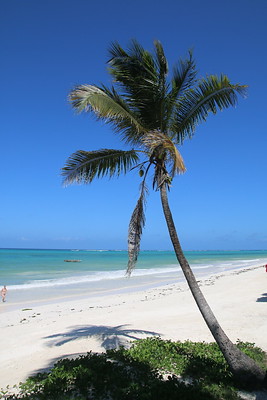
Herbaceous plants are plants whose above-ground plant parts die back to the soil surface at the end of the growing season. Herbaceous plant shoots grow in length and diameter in the same way that roots do: the apical meristem at the tip of the stem produces new cells and then those new cells enlarge in length and volume in the region of elongation just behind the meristem. Stems of herbaceous plants typically do not thicken very much and rely instead on branching to grow laterally (although there are exceptions like sunflower and tomato whose stems do thicken noticeably). Branching of the shoot is initiated at nodes where there are axillary buds containing axillary meristems that grow into branches.
Continued growth of the stem in diameter, like you find in a tree where the trunk and branches increase in diameter each year, requires an active lateral meristem called the cambium. Cambium is a meristem in the vascular tissue positioned between the xylem and phloem that continues to produce new xylem cells toward the interior of the stem and new phloem cells toward the exterior. Production of xylem and phloem from cambium cells is called secondary growth and is typical of woody perennial plants. We will explore plants with secondary growth in a different lesson.
Some herbaceous plants are annuals, like beans and pansies, where the whole plant dies over the winter. These plants complete their life cycle from seed to flower to seed in one year. Other herbaceous plants, like Kentucky bluegrass and chrysanthemums, are herbaceous perennials where only the above-ground growth dies over winter (unless it is a really nasty winter). The root, or in some cases underground stem tissue, stores nutrients for the next season’s growth. In spring when soil and air temperatures are sufficiently warm, new shoots emerge from nodes on compact stem tissues often called crowns. The cells in the crown tissue survive the harsh winter temperatures because they accumulate sugars and other compounds that act as antifreeze compounds. They are located very close to the soil surface, or even protected a bit by the soil. This position on or in the soil, plus snow cover, results in much warmer temperatures around the crown than the air temperature above the snow. In fact, the air temperature can be -20°F above the snow and only a few degrees below freezing (32°F) around the crown.
Dicotyledonous stems
Watch this video for a detailed description of dicot stems (2:19).
This micrograph of a herbaceous dicot stem shows four basic parts (in order from outside to inside): epidermis, cortex, vascular bundle, and pith. Notice how the vascular bundles of dicots are arranged in a ring around the circumference of the plant stem with the cortex to the outside and pith to the inside.
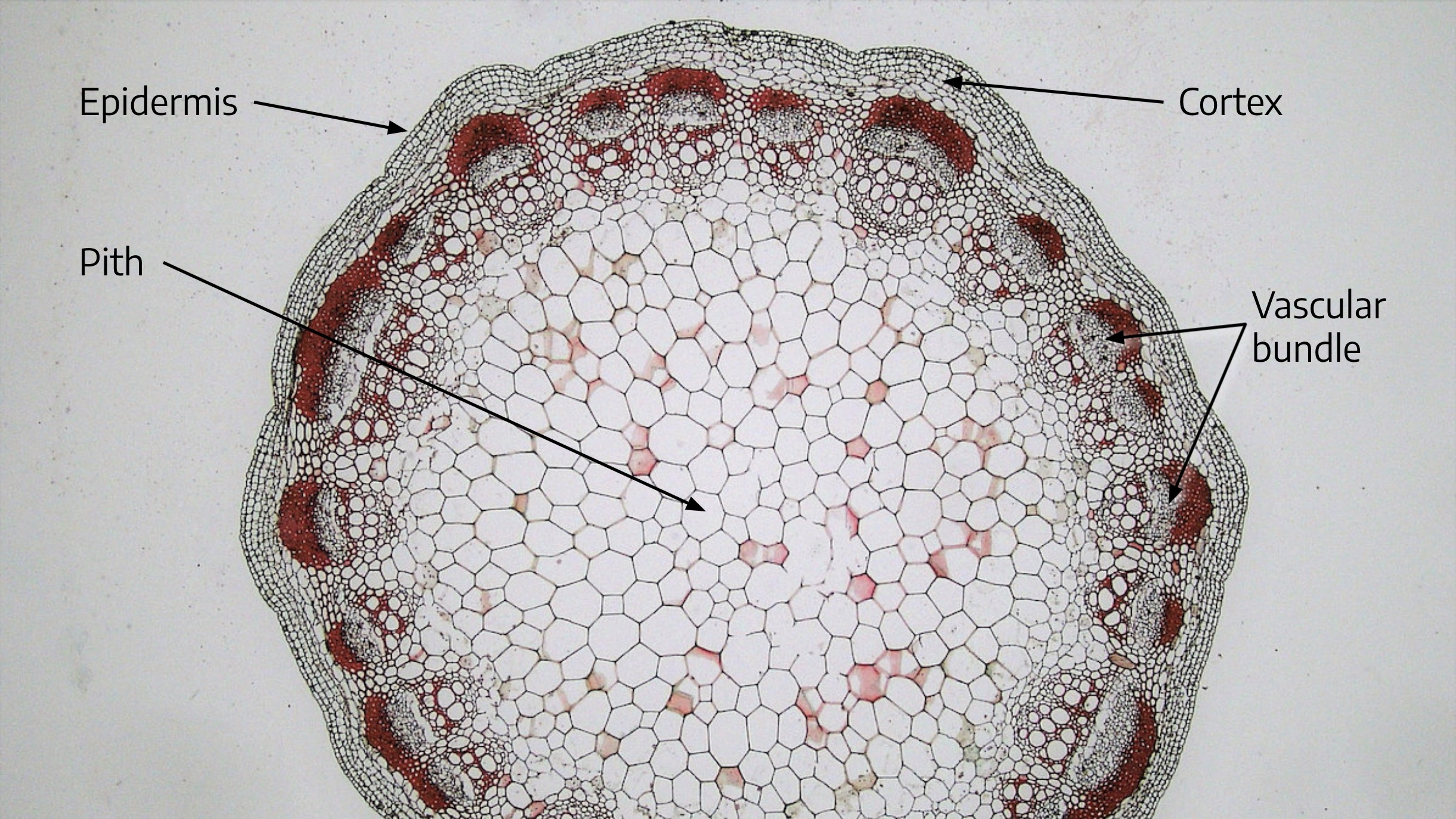
Epidermis – This tough covering is a single layer of living cells. These cells are closely packed and function to protect the internal parts of the plant. The walls are thickened and covered with a thin waxy waterproof layer called the cuticle that reduces water loss from the plant. Stomata with guard cells are found in the epidermis, and these function to allow gasses into and out of the stem, similar to their function in leaves. In some stems either unicellular or multicellular hair-like outgrowths, called trichomes, appear from the epidermis. Below is an image of trichomes on a tomato stem, inflorescence, and leaf.
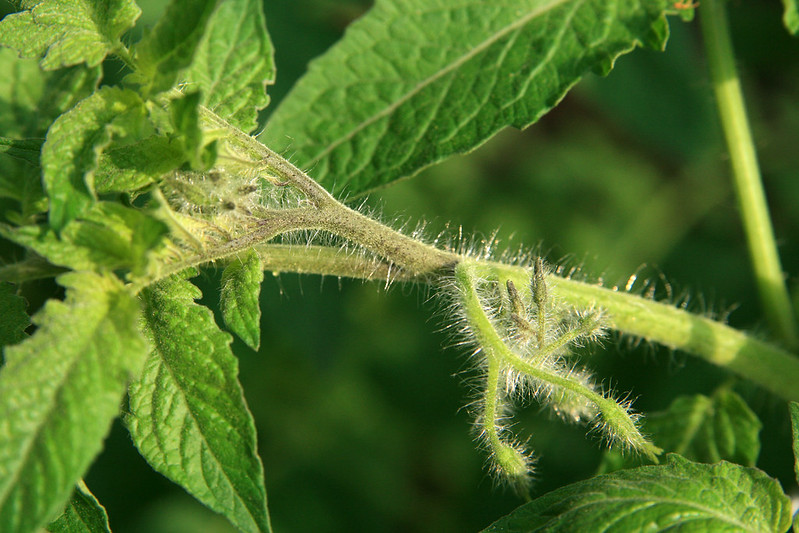
Cortex – Also known as the ground meristem, the cortex is found just inside the epidermis and extends toward the interior of the stem. It is made up of three types of cells: parenchyma, collenchyma, and sclerenchyma.
Vascular bundles – This region contains sclerenchyma fibers that strengthen the stem and provide protection for the vascular bundle. In dicots, the vascular bundles form a distinct ring. A mature vascular bundle consists of three main tissues – xylem, phloem, and cambium. The phloem is always located toward the outside of the bundle and the xylem always toward the center. The cambium separates the xylem and phloem, and, in those plants where secondary growth takes place, the cambium produces new xylem and phloem cells: xylem toward the center, phloem toward the outside.
The pith occupies the central part of the stem and is composed of thin-walled parenchyma cells often with larger intercellular spaces than you would find in the cortex.
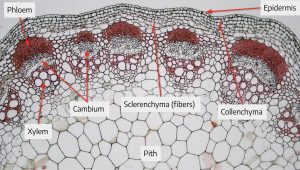
In this cross section of a dicot stem note the collenchyma cells in the cortex just under the epidermis. Sunflower stems are quite tough, and this toughness is in part due to the layer of collenchyma cells positioned to give the stem mechanical stability. Toward the outside of each vascular bundle are fibers of sclerenchyma that also contribute to the sunflower stem’s toughness. Then, moving from the outside to the inside, you will find phloem, a layer of cambium, and then xylem. The pith is in the center.
Now you might recall that just above we said that herbaceous annuals like sunflower don’t have cambium to increase the girth of the stem, so what’s with the cambium in this picture of a sunflower stem? Well, you will see a layer of cambium between the xylem and phloem of dicot stems, and it is active for a while and produces a modest amount of xylem and phloem which contributes to the sunflower’s larger diameter stem. However, this cambium tissue is not continuously active as in woody stems, and the plant does not survive through the winter.
Monocotyledonous stems
The tissues making up monocot stems are essentially the same as what we saw in dicots with the main difference apparent in the placement of the vascular bundles. In monocots, vascular bundles are scattered throughout the stem instead of being oriented in a ring. Since there is no ring of vascular bundles, there is no “inside” pith and “outside” cortex. All the ground tissue is considered to be cortex.
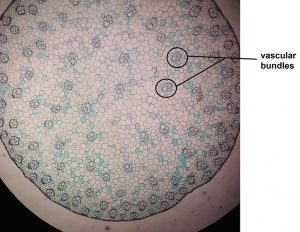
In monocot vascular bundles the phloem is always oriented toward the outside of the plant and the xylem toward the inside. There is no cambium and no secondary growth. Around the outside of the vascular bundle is a layer of parenchyma cells called the bundle sheath. This layer of cells is very important in photosynthesis. For now we will consider it a protective covering and supportive sheath around the vascular bundle.
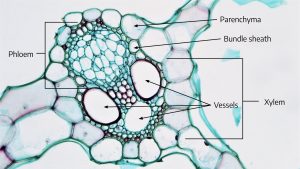
One final note
So why the palm tree? Because it is an exception.
A palm tree is a monocot, but unlike other monocots whose stems are quite thin (like grasses, for instance), their primary stems do increase in girth from year to year even though they do not have secondary cambium. Palms have a special layer of meristematic cells, called the primary thickening meristem, oriented toward the outside of the stem that each year can initiate new vascular bundles and new parenchyma cells. Each year the stem expands in girth as a result of the palm’s production of new parenchyma and vascular bundles. You don’t need to memorize this – it is just an example of an interesting exception to the rule.
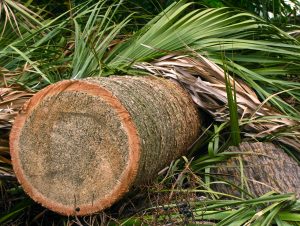
Review questions
After completing this section, you should be able to answer these questions:
- Herbaceous perennials die back to the ground in the spring. Where do they get the energy to grow the next spring, and from what tissue do new shoots emerge?
- Dicots typically have a pith while monocots do not. Why?
- Could you distinguish between a monocot and dicot stem based on the arrangement of the vascular bundles?
Plants whose above-ground parts die back to the soil surface at the end of the growing season.
Group of more or less continually dividing cells located at the tip of a shoot or root.
Bud borne in the axil of a stem.
Group of more or less continually dividing cells located at the axils of a stem.
Lateral meristem in vascular plants, including the vascular cambium and cork cambium, that forms parallel rows of cells resulting in secondary tissues.
Production of xylem and phloem from cambium cells.
Plants where only the above-ground growth dies over winter. The underground portion lives for more than two growing seasons (two years).
Compact stem tissue at or near the soil surface.
Seed plant that produces an embryo with paired cotyledons, floral organs arranged in cycles of four or five, and leaves with net-like veins.
Occupies the central part of the stem and is composed of thin-walled parenchyma cells often with larger intercellular spaces than you would find in the cortex.
Either unicellular or multicellular hair-like outgrowths arising from the epidermis; found on stems.
Plants that completely die over winter. These plants complete their life cycle from seed to flower to seed in one year.
Seed plant that produces an embryo with a single cotyledon and parallel-veined leaves; includes grasses, lilies, palms, and orchids.

